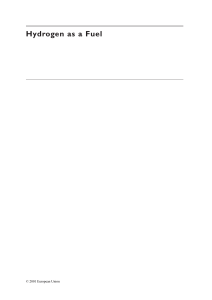Figure S4. Characteristics of the glucose fermentation for
advertisement
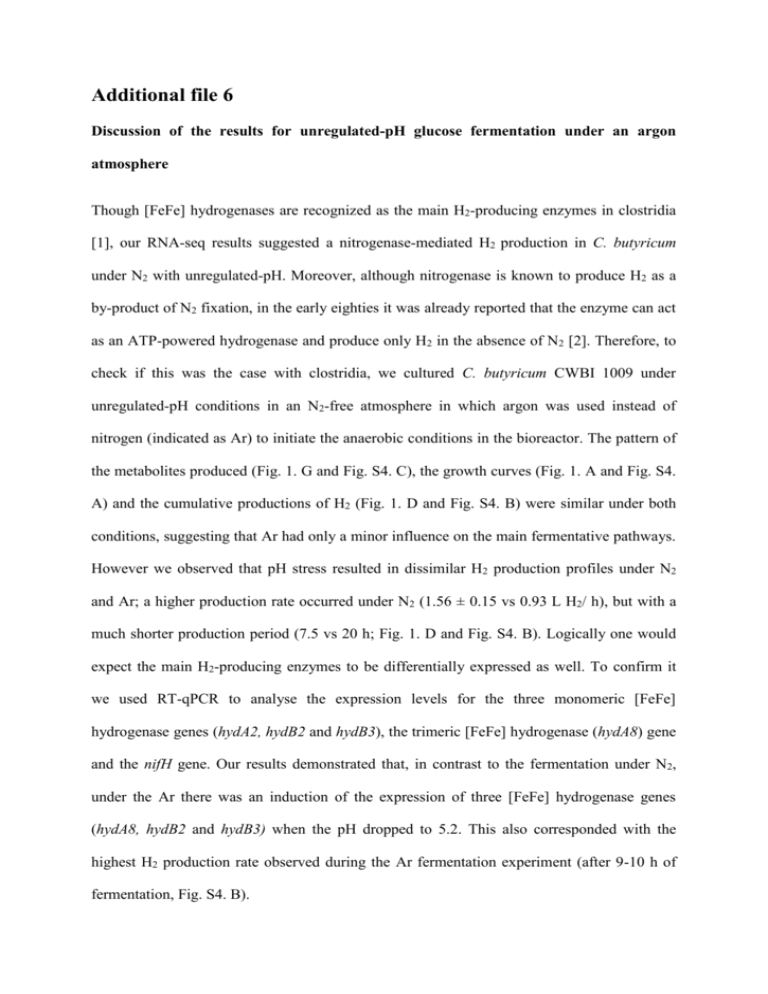
Additional file 6 Discussion of the results for unregulated-pH glucose fermentation under an argon atmosphere Though [FeFe] hydrogenases are recognized as the main H2-producing enzymes in clostridia [1], our RNA-seq results suggested a nitrogenase-mediated H2 production in C. butyricum under N2 with unregulated-pH. Moreover, although nitrogenase is known to produce H2 as a by-product of N2 fixation, in the early eighties it was already reported that the enzyme can act as an ATP-powered hydrogenase and produce only H2 in the absence of N2 [2]. Therefore, to check if this was the case with clostridia, we cultured C. butyricum CWBI 1009 under unregulated-pH conditions in an N2-free atmosphere in which argon was used instead of nitrogen (indicated as Ar) to initiate the anaerobic conditions in the bioreactor. The pattern of the metabolites produced (Fig. 1. G and Fig. S4. C), the growth curves (Fig. 1. A and Fig. S4. A) and the cumulative productions of H2 (Fig. 1. D and Fig. S4. B) were similar under both conditions, suggesting that Ar had only a minor influence on the main fermentative pathways. However we observed that pH stress resulted in dissimilar H2 production profiles under N2 and Ar; a higher production rate occurred under N2 (1.56 ± 0.15 vs 0.93 L H2/ h), but with a much shorter production period (7.5 vs 20 h; Fig. 1. D and Fig. S4. B). Logically one would expect the main H2-producing enzymes to be differentially expressed as well. To confirm it we used RT-qPCR to analyse the expression levels for the three monomeric [FeFe] hydrogenase genes (hydA2, hydB2 and hydB3), the trimeric [FeFe] hydrogenase (hydA8) gene and the nifH gene. Our results demonstrated that, in contrast to the fermentation under N2, under the Ar there was an induction of the expression of three [FeFe] hydrogenase genes (hydA8, hydB2 and hydB3) when the pH dropped to 5.2. This also corresponded with the highest H2 production rate observed during the Ar fermentation experiment (after 9-10 h of fermentation, Fig. S4. B). When comparing the respective stages of glucose fermentations under an Ar versus an N2 atmosphere, we observed that for the stages associated with peak H2 production, the expression level of hydA8, hydB2 and hydB3 was 0.78, 2.58 and 3.75 fold higher (log2 scale) respectively under Ar (Fig. S5. A). The expression level of the hydA2 gene was unchanged between the two conditions. Hydrogenase HydA2 seems to be the only C. butyricum CWBI 1009 [FeFe] hydrogenase that is relatively constantly expressed under different pH and N2availability conditions. The up-regulated hydrogenase HydB3 is similar in modular structure to the well characterized HydA2 [3], though neither its gene expression nor the protein itself have been studied before. Here we clearly demonstrated that [FeFe] hydrogenases other than HydA2 may also influence H2 production in clostridia. The most remarkable difference observed was that the average expression level of the nifH gene was more than 11-fold lower (log2 scale) during fermentation under Ar compared to N2 (Fig. S5. A and B), and that the NifH subunit could not be detected by Western blot analysis (Fig. S5. C). Interestingly, it has recently been reported that the presence of ethanol stimulated transcription of nifHDK genes by increasing the nifA expression, and enhanced the overall H2 production by 60% in Rhodobacter sphaeroides when grown in an ammonium-containing medium [4]. The metabolic similarities between Rhodobacter and clostridia may be limited, but the work of Oh et al. [4] illustrates the existence of complex regulation patterns that are still far from being deciphered. As shown in Figs. 1. G and S4. C, it is interesting to note that ethanol is indeed produced in both unregulated-pH fermentations under N2 and Ar. In our study ammonium must have been produced by nitrogenase activity under N2, but not when N2 was replaced with Ar. If there exists a similar regulation by ethanol when ammonium is present, its absence could potentially explain the lower transcriptional level of nif genes under Ar. However, a better understanding of the differences between the mechanisms leading to H2 production in clostridia under these two atmospheric conditions studied would require a more detailed analysis of the Ar sample at the transcriptomic or proteomic level (this was not performed as it was beyond the scope of this study). Additionally [FeFe] hydrogenase and nitrogenase activity assays could help to evaluate the contribution of each enzyme to the overall H 2 production under different environmental conditions. References 1. Vignais PM, Colbeau A: Molecular biology of microbial hydrogenases. Curr Issues Mol Biol 2004, 6: 159-188. 2. Burgess BK, Wherland S, Newton WE, Stiefel EI: Nitrogenase reactivity: insight into the nitrogen-fixing process through hydrogen-inhibition and HD-forming reactions. Biochem 1981, 20: 5140-5146. 3. Calusinska M, Happe T, Joris B, Wilmotte A: The surprising diversity of clostridial hydrogenases: a comparative genomic perspective. Microbiol 2010, 156: 1575-1588. 4. Oh EK, Kim EJ, Hwang HJ, Tong X, Nam JM, Kim MS et al.: The photoheterotrophic H2 evolution of Rhodobacter sphaeroides is enhanced in the presence of ethanol. Int J Hydrogen Energ 2012, 37: 15886-15892. Figure S4. Characteristics of the glucose fermentation for Clostridium butyricum CWBI 1009 performed under unregulated-pH conditions and Ar atmosphere. (A) Growth curve (OD) and pH. (B) Hydrogen production rate (L/ h) and cumulative hydrogen production (L) profiles. (C) Glucose utilization and profiles of soluble metabolites (mM). The fermentation was performed in 20 L batch bioreactors with glucose as a substrate (10 g/ L). Figure S5. Relative expression of [FeFe] hydrogenases and nifH genes determined by RT-qPCR for Clostridium butyricum CWBI 1009 during unregulated-pH glucose fermentation under N2 and Ar atmosphere. Western blot analysis for the NifH subunit. (A) Fold change in the expression level of hydA2, hydA8, hydB2, hydB3, nifH genes during unregulated-pH glucose fermentation under Ar (test sample) vs N2 (control sample). The values correspond to the late exponential growth stages from both experiments, characterized by the peak in H2 production and pH values of 5.2 for Ar and pH 6.3 for N2. (B) Basal expression levels of the hydA2, hydA8, hydB2, hydB3, nifH gene transcripts during unregulated-pH glucose fermentation under N2 and Ar. The expression level is shown as a number of cDNA copies per 1000 cDNA copies of 16S rRNA. The values correspond to the late exponential growth stages from both experiments corresponding to the peak in H2 production and pH values of 5.2 for Ar and pH 6.3 for N2. (C) Western blot analyses of the crude cellular extracts taken during unregulated-pH glucose fermentation under N2 and Ar. Time of incubation corresponds to the different growth stages starting from the beginning of the experiment until the pH dropped to a level of about 4.5 for both fermentations. The arrow indicates the pH 6.3. Pc-positive control. Table S13. Bioreactor performance of Clostridium butyricum CWBI 1009 cultivated in a 20 L batch bioreactor with glucose (10 g/ L) under unregulated-pH conditions and N2 or Ar atmosphere. Growth Growth rate DO600nm div.h-1 N2 atmosphere 2.5 ±0.1 0.50 ±0.02 N2-free atmosphere 2.6 a 0.59 Glucose uptake g glucose/ h Biogas H2 contenta H2 CO2 H2 yield H2 rate L % L L mol H2/ mol glucose L H2/ h 0.84 ±0.06 17.16 ±0.84 63 ±4 10.80 ±0.44 6.36 ±0.28 1.78 ±0.11 1.56 ±0.15 0.77 19.97 58 11.78 8.19 1.39 0.93 The H2 content is the average of all the measurements carried out during the exponential growth phase (5-10 h of fermentation).


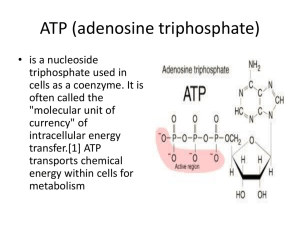
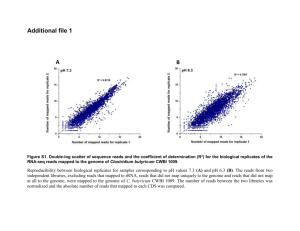
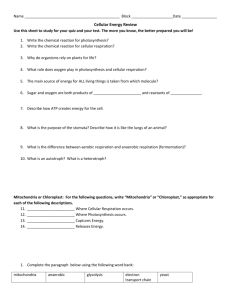
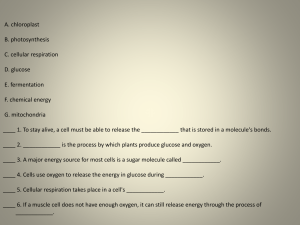



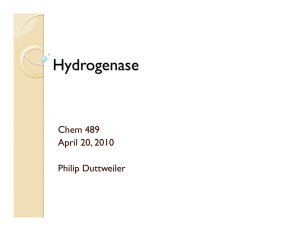
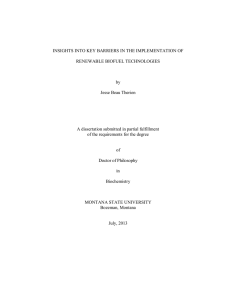
![[FeFe]- and [NiFe]-hydrogenase diversity, mechanism, and maturation](http://s2.studylib.net/store/data/013550431_1-384b5dce0e961c87cdb6e93c847d8d28-300x300.png)
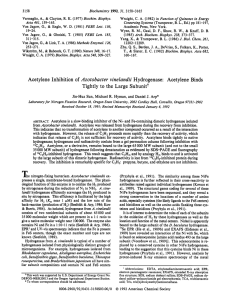
![[FeFe] hydrogenases - Ruhr](http://s2.studylib.net/store/data/018308091_1-f3b121f1d43b073e9b0b2b18a5ff98a4-300x300.png)
